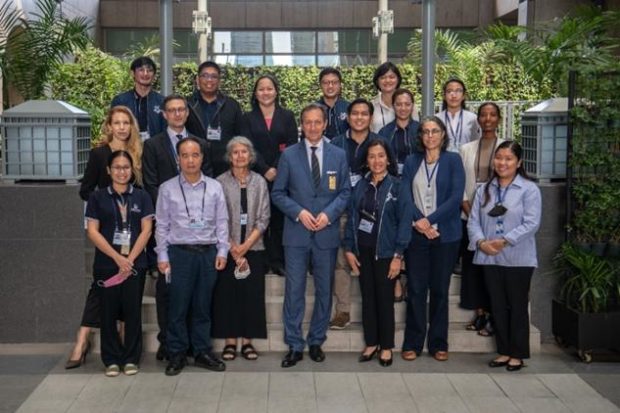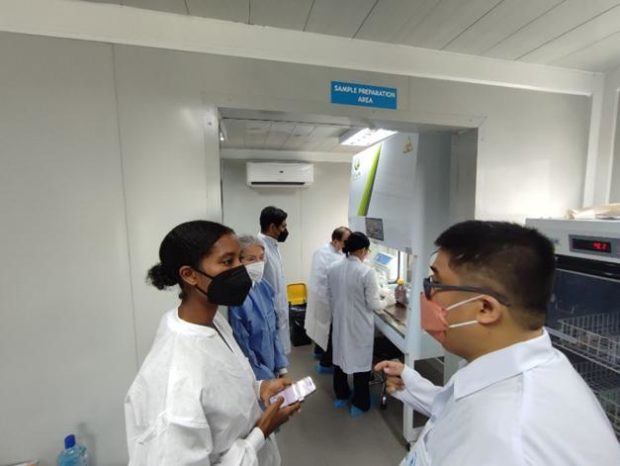Full-scale WBE for SARS-CoV-2 surveillance in Metro Manila launched

In photo: Ambassador of Austria to the Philippines H.E. Johann Brieger and his delegation, Emory University consultants led by Dr. Christine Moe, Asian Development Bank representative Graziel Salazar, Manila Water Technical Services Division Head Estelita Orodio, Laboratory Services Department Head Joy De Vera, and Wastewater Operations representatives during the launch of the full-scale implementation of Wastewater Based Epidemiology for SARS-Cov-2. Contributed photo
Wastewater-based epidemiology (WBE) for SARS-CoV-2 in the Philippines has officially begun, thanks to the efforts of the Asian Development Bank (ADB) and Emory University’s Center for Global Safe Water, Sanitation, and Hygiene, working in collaboration with Manila Water.
With the first-ever molecular laboratory completed in Ilugin Sewage Treatment Plant in July of this year, Manila Water began piloting the use of WBE for COVID-19 surveillance in Metro Manila (STP).
The facility is designed to detect and quantify emerging water contaminants, including the SARS-Cov-2 virus, in wastewater using polymerase chain reaction (PCR) machines, which are capable of amplifying small segments of DNA or RNA to an amount large enough to be studied in detail.
READ: Manila Water to start monitoring wastewater for SARS-CoV-2
As part of ADB’s Accelerating Sanitation for All in Asia and the Pacific (TA 9897), the project aims to help Manila Water develop its capabilities to do wastewater-based epidemiology for surveillance of SARS-CoV-2, along with its current lab.
ADB received a $1.1 million grant from the Austrian government to support activities related to environmental surveillance and wastewater-based epidemiology approaches, which complement the objectives of citywide inclusive sanitation, sustainability, and climate change.
Article continues after this advertisementIt will enable Manila Water to pursue water security for its 7.4 million customers and aggressively seek public health measures globally recognized to ensure that the East Zone population and its local government units are prepared for further COVID-19 infections.
Article continues after this advertisement
Under the wastewater surveillance project, the proponents will develop a Wastewater Based Epidemiology sampling and testing protocol to be incorporated into Manila Water’s operations. The data collected from the wastewater surveillance can be used as the basis for crafting health and safety policies on COVID-19 and determining emerging water contaminants.
To ensure that all people, especially those in poor and vulnerable communities, have access to safe and affordable sanitation services, Sustainable Development Goal 6.2 is being supported through this technical assistance.
Emory University and Manila Water are collaborating on the initiative to establish a WBE sampling and testing technique that can be implemented throughout the Company. They will also develop and deliver a curriculum for teaching about sampling and testing, both formally and informally.
READ: Manila Water to construct more wastewater facilities to help curb pollution
The five-day inception visit of ADB and Emory University representatives last November 7-11 started with a meeting at the ADB Headquarters, attended by the ambassador of the Government of Austria to the Philippines, H.E. Johann Brieger, representatives of ADB and Manila Water, and Emory University consultants led by their director, Dr. Christine Moe.
Several presentations were discussed during the meeting, including the introduction, discussion, and knowledge sharing of possible approaches for WBE in the East Zone of Metro Manila by Dr. Moe and her team, and the introduction of Manila Water’s Wastewater Operations and Molecular Laboratory profile by Emmanuel Jimenez, head of the Company’s Research and Development.
Manila Water also took its partners on a laboratory tour and field site visits of various wastewater facilities, including STPs at Ilugin, Capitolyo, and Makati South; Magallanes Pumping Station; FTI Septage Treatment Plant (SpTP), and actual witnessing of desludging activity at a residential area in Taguig City. These activities helped depict actual site characteristics and design initial sample sites for WBE in the East Zone.
The group also met with the Department of Health, Research Institute for Tropical Medicine, University of the Philippines Manila, Metropolitan Waterworks and Sewerage System, and World Health Organization to discuss WBE in a stakeholders’ meeting.
The proponents aim to use the data collected from wastewater surveillance to craft health and safety policies on COVID-19 and address public health issues caused by existing and emerging water contaminants. The use of WBE was also proven to incur less cost than nationwide clinical testing since the virus can be detected in the human waste of both symptomatic and asymptomatic persons infected with COVID-19.